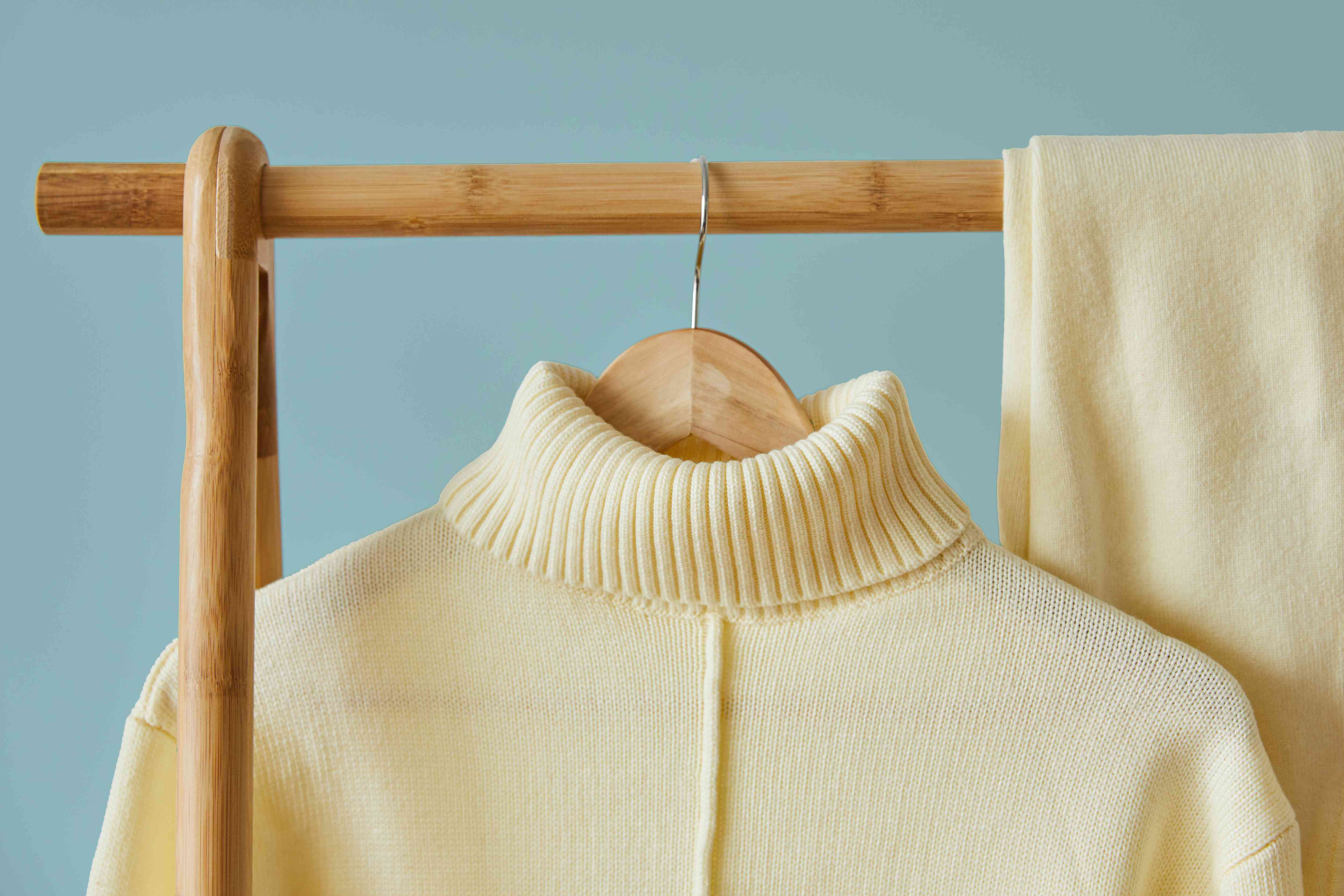
Sweaters are a mainstay in any cold-weather wardrobe and when you find one you love, you want it to last as long as possible. Most cotton, acrylic, ramie, bamboo, and wool fiber sweaters can be washed at home using the right techniques. How you clean and store them can make the difference between a stretched or shrunken fit and a soft or scratchy feel. We talked to two laundry experts and put together their best eight tips on extending the life of your sweaters.
Zach and Jerry Pozniak are the owners of Jeeves New York, a luxury dry-cleaning company, and authors of The Laundry Book.
Store Sweaters Correctly
Sweaters are made from knitted yarns with much more give and stretch than woven fabrics. While that stretch makes them comfortable, it also means that they can become misshapen more quickly. “We recommend that knits either be folded over a hanger for closet storage or stored in drawers or on shelves,” said Zach Pozniak. “Sweaters need to be supported correctly so they do not get misshapen or damaged by hangers.”
To prevent damage to wool sweaters from moths and other insects, clean sweaters before you store them, and add sachets of cedar chips or lavender.
Read the Care Label
It’s important to know what type of fibers were used to make your sweater and how it should be cleaned. The care label will give you directions on what water temperature to use and whether it can be machine-washed or should be hand-washed.
Wash Gently
If you’re machine-washing a sweater, turn it inside out and place it in a mesh laundry bag (a delicates bag) before tossing it in the washer. Use cool water, a mild detergent, and the gentle cycle.
When hand-washing sweaters, wash each one separately using cool water and a mild detergent. “You do not need a lot of detergent as you are using a very small amount of water in a sink,” Jerry Pozniak says.
Fill the sink with cool water and add about 1/4 teaspoon of detergent.Submerge the sweater and be sure that all of the fibers are saturated with the soapy water.Allow it to soak for about 10 minutes.Gently agitate the sweater through the water.Lift it out of the soapy water and support it well (don’t stretch out the wet fibers).Drain the sink and refill with clean water for rinsing.Rinse the sweater and gently squeeze out the excess water. No wringing!
Air Dry Flat
While some sweaters may say they can be tossed in the dryer, you’ll be able to better maintain their condition by air drying them flat. Mesh drying racks that can be placed over the bathtub are best because they offer 360-degree air circulation. You can also use a thick towel on a counter or floor. Just be sure to protect any wooden surfaces from moisture, replace the towel as it gets wet, and turn the sweater often.
When drying a sweater flat, reshape it into its original shape to prevent excessive wrinkles or stretching.
Remove Pills Correctly
Pilling happens, especially on knitted items, but the tighter the weave, the less the sweater will pill. The pills appear when groups of short or broken fibers become tangled together in a tiny knot or ball on areas that receive the most abrasion during normal wear and use (like the armpit or elbow areas).
The best way to remove the pills from the surface of a sweater is to use a battery-powered fabric shaver. You can also snip off the pills with tiny, sharp scissors but run the risk of cutting a hole in the sweater.
Tighten Stretched Cuffs and Necklines
Stretched cuffs and necklines on natural fiber sweaters, like cotton or wool, can be tightened with heat to improve the sweater’s appearance.
Add boiling water to a small bowl.Dip the cuffs in the hot water and reshape. For necklines, carefully dip a clean cloth or sponge in the hot water and dampen the neckline. Reshape.Allow the treated areas to air-dry or use a blow dryer on high heat to speed drying and increase shrinkage.
Save a Shrunken Sweater
It has happened to everyone, a sweater ends up in a washer cycle using hot water and shrinks. Take these steps that could save it before you toss it. These steps will be the most effective on natural fibers but can also help relax synthetic fiber sweaters.
Fill a sink with cool water and add two tablespoons of baby shampoo or liquid fabric softener.Add the sweater, and gently swish it through the solution. Soak for at least 30 minutes or up to two hours. Remove the sweater from the solution, but don’t rinse. Gently squeeze out excess moisture. No wringing!Place the sweater flat on a thick cotton towel, and roll it up to absorb as much moisture as possible.Block the sweater using a sturdy cork bulletin board or a blocking board. Gently stretch the sweater back to its original shape and pin it in place with stainless steel pins. Pin the sweater every two inches to hold it in place and allow it to air dry.
Don’t place the sweater in a hot dryer. Once it goes through the dryer, there’s pretty much no hope.
Wash and Wear Less Often
Overall, the best way to extend the life of your sweater is to wash and wear it less often.
Spot treat stains as soon as they happen.Always wear a washable t-shirt or blouse under the sweater to reduce body soil.Skip a day between each wearing to allow the fibers to return to their natural shape to prevent baggy elbows, necklines, and cuffs.